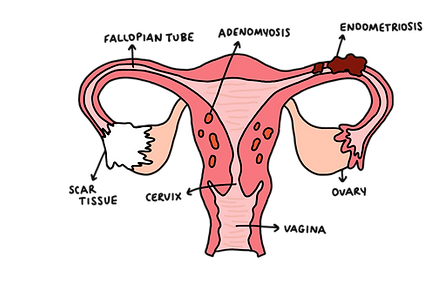Understanding Adenomyosis

Endometriosis is often linked to adenomyosis, a condition estimated to affect 1 in 10 women and individuals assigned female at birth.
Adenomyosis occurs when endometrial-like tissue grows within the muscle wall of the uterus (myometrium). This can cause the uterus to thicken, enlarge, and increase in size over time. As the condition progresses, the uterus may grow significantly larger than its normal size, leading to discomfort and other symptoms.
It is not uncommon for people to have both adenomyosis and endometriosis.
Symptoms of adenomyosis
Adenomyosis can cause a range of symptoms, though experiences vary from person to person. Common symptoms include:
-
Pelvic pain
-
Heavy or prolonged menstrual bleeding
-
Pelvic pressure or bloating
-
Pain during menstruation, sexual intercourse, or bowel/bladder movements
-
Abdominal swelling
-
Fatigue (extreme tiredness)
-
Pregnancy complications (such as miscarriage) or infertility
If you are experiencing persistent pain that interferes with your daily life or have noticed changes in your menstrual cycle, it’s important to speak with a doctor as soon as possible. These symptoms may indicate adenomyosis or another underlying condition that requires medical attention.
Diagnosing adenomyosis
Like endometriosis, diagnosing adenomyosis can be challenging, as there is no single test to confirm it. Diagnosis often involves physical examinations, symptom assessments, and specialist referrals.
Previously, the only definitive way to diagnose adenomyosis was through hysterectomy (surgical removal of the uterus), where the tissue could be examined under a microscope. However, advancements in medical imaging now allow many specialists to identify adenomyosis using ultrasound or MRI scans.
Treatment options
There is no universal treatment for adenomyosis, but symptom management often includes:
-
Pain relief and medication – such as Tranexamic Acid and Mefenamic Acid to reduce bleeding and inflammation
-
Hormonal treatments – including the contraceptive pill, hormonal injections, or the Mirena coil (IUD) to help manage symptoms
-
Lifestyle changes and holistic therapies – including diet, exercise, and complementary treatments
Medical and Surgical Interventions
For severe cases, additional treatments may be necessary:
-
Uterine artery embolization (UAE) – a procedure that blocks blood supply to affected areas
-
Hysterectomy (removal of the uterus) – the only known cure for adenomyosis, though it is a major surgery and should be considered only after all other options have been explored. A hysterectomy is typically recommended only when family planning is complete or when having children is no longer an option or a preference.
Whilst it is not uncommon for people to have both Adenomyosis and Endometriosis, it’s important to know they are two different conditions.



